Just days after publishing a report insisting that Samsung Electronics is now more profitable in handsets than Apple, Strategy Analytics is back with a new claim that states Apple's iPad has shriveled up to just 28.3 percent of the tablet market in the June quarter. There are some very serious problems with this data, too.
Strategy Analytics' initial claims about profitability were trivial to take apart. As public corporations, both Apple and Samsung provide audited accounting of their profits. Strategy Analytics simply introduced an accounting trick to generate an alarming headline, one that, even if it were true, wouldn't really be very significant.
Nobody in the industry has ever been concerned about the specific profitability of two product segments pulled from two different companies. Nobody has ever reported how profitable Microsoft Word is in comparison to every other word processor that isn't Word, for example, or compared the profits of Google's Chrome OS browser group with, say, Opera Software. Such a comparison wouldn't really make sense or provide any real insight.Of all the tablet manufacturers on the planet, only Apple's iPad actually reports its unit sales.
However, there's intense popular interest in finding facts to support the idea that iPad sales will be dominated by low priced tablets, the same way the industry looked for evidence of iPods being cannibalized by mobile phones that could play MP3s prior to the iPhone, or tried to find proof of Apple's profits drying up due to Android phone sales after the iPhone.
One problem in factually verifying Apple's true market share standing in the tablet industry is that, of all the tablet manufacturers on the planet, only Apple's iPad actually reports its unit sales. That fact makes it much easier for market research companies to estimate numbers of competing shipments with variable degrees of accuracy and with zero accountability.
Extreme controversy in tablet shipment estimates
IDC hasn't reported its Q2 tablet figures yet, but for the quarter ending March 2013, it said the industry sold a total of 49.2 million tablets. Apple reported selling 19.5 million, more than the rest of IDC's top five (Samsung, Asus, Amazon and Microsoft) combined. But that wasn't enough to account for more than 40% of the tablet market, IDC reported, because "Other" had sold a whopping 15.5 million tablets.
Curiously, for the same Q1 2013, Digitimes Research reported just two buckets of tablets: iPad and "non-iPad." While it agreed with IDC on the number of tablets that Apple sold, it reported that the rest of the industry only sold 12.4 million, 2.3 million fewer than IDC counted among just the top five, even before wondering who the "Other" was selling those 15.5 million IDC tablets without a readily recognizable name attached to them.
In total, Digitimes counted 17.8 million fewer tablets than IDC. That's nearly as many doppelgänger tablets as Apple sold worldwide. That's way too large of a difference to be attributed to a rounding error. At least one of these firms is completely not even close to providing useful quarterly tablet numbers.
Next up, look at Strategy Analytics, which reported "global branded tablet" shipments of 40.6 million in Q1. Once again, the only number it reported in common with IDC and Digitimes is Apple's 19.5 million iPads.
Strategy Analytics reported 3 million tablets running Windows, while IDC said Microsoft alone had shipped 0.9 million and that "total combined Windows 8 and Windows RT shipments across all vendors reached 1.8 million," a difference of 1.2 million, or just 40 percent of Strategy Analytics' figure for Windows tablets.
Given that there isn't much going on outside of iPad, Android and Windows in the tablet space, IDC's remainder of 27.9 non-iPad, non-Windows tablets is in even greater discrepancy with Strategy Analytics, which counted 18.1 million branded tablets fitting that description. That's 9.8 million non-Windows, non-iPad devices that have gone missing, quite nearly half the number IDC counted. On the other hand, Strategy Analytics is also 8.7 million tablets in excess of Digitimes.
Being off by around nine million units in either direction is a pretty vast error. That's the total number of PCs Dell sold in the quarter. At least two of these market research companies are not even close to reporting the actual numbers for tablets sold in the industry. It is insulting to intelligence that these numbers are so obviously garbage, yet are recited as established fact by any journalist who gets the press release in their inbox. The tablet industry is clearly full of phony information, whether by intent or incompetence.
Gartner and IDC regularly report variations in their sales estimates for the PC industry, too, resulting in, for example, differing figures for this same Q1 2013: Gartner assigned Apple an 11.6 percent share of the PC market and reported year-over-year Mac share growth of 7.4 percent, while IDC said Apple had accounted for just 10 percent of the PC market and said its share had actually contracted by 7.5 percent over the year ago quarter.
Despite these dramatically different interpretations of their data, Gartner and IDC both reported total U.S. PC shipments for the quarter that were only off by 26,000 units and differed in their estimates of U.S. Mac sales by just 232,000 units. Total tablet figures are more controversial by a factor of more than 340.
Strategy Analytics doesn't even agree with Strategy Analytics
One could argue that these firms are counting different groups of products using different methodologies, or that one or more of them are perhaps shifting millions of inventory shipments by certain companies (other than Apple, of course) between quarters.Research companies are getting much worse at counting tablets as time goes on.
However, among products, IDC says it "considers all LCD-based slate devices with screens between 7 and 16 inches as tablets," excluding convertible tablets. Strategy Analytics similarly says its "definition of tablet does not include e-book readers or convertible PCs," indicating that they're not simply mixing up netbooks, notebooks and digital picture frames into their tablet numbers.
Grouped together over time, the numbers seem to diverge less. The average difference in total tablets counted between IDC and Strategy Analytics across four of the last six corresponding quarters (that I could find publicly reported) were "only" off by an average of 3.3 million per quarter. That's still terrible, but not as bad as being off by 9 million or more.
When you only look at the first three quarters initially reported for 2012, the two firms' numbers are off by roughly one million per quarter. That indicates the research companies are getting much worse at counting tablets as time goes on.
Even more puzzling is the fact that last year, Engadget cited Strategy Analytics as reporting 24.9 million tablets sold in Q2 2012: 17 million by Apple, 7.3 million attributed to Android, and 0.3 million assigned to both Microsoft and to Other (below). The site enshrined the data into a graphic file and installed it on the web as history. And then something terrible happened.
This year, Strategy Analytics announced Q2 2013 tablets figures that cited the 14.6 million iPads Apple reported selling, a huge increase of 34.6 million Android tablets, 2.3 million new Windows (rather than "Microsoft") tablets, 0.1 million BlackBerry tablets and zero Other, a total of 51.7 million.
But the company also included comparison numbers for the year-ago quarter. They were not the same as the company had reported a year ago (above). Strategy Analytics' figures for last summer had shifted Microsoft Windows tablets down by a third to 0.2 million, but retroactively increased its Android numbers by 11.2 million for a new year-ago Q2 total of 18.5 million (below).
Strategy Analytics invents the White Box Tablet
Peter King, the Director of Tablets at Strategy Analytics who authored the report, explained that in the most recent Q2 2013, the "the branded Tablet market had a rest period as very few new products came to market during the quarter." That explains why Samsung and Asus aren't selling gangbuster tablets, even though Android reportedly is, at least according to Strategy Analytics.
If Strategy Analytics had only reported "branded tablets," as it had been doing over the past year, it would have reported 36.2 million tablets for the most recent June quarter, giving Apple 40.3 percent share of the market. But then it couldn't claim "Android Dominates the Tablet Market in 2013 Q2 with 67 Percent Share of Global Tablet Shipments."
Fortunately for that sensational headline, King had discovered a new category called "White-Box Tablets," defined as a "product produced by one company that other companies rebrand to make it appear as if they made it." This added 15.5 million shipments to the Android column, allowing King to report, "Android secured a robust 67 percent global share, while Apple iOS declined further to 28 percent."Because White-Box Tablets hadn't been invented in 2012, they had to be retroactively added to the year ago quarter: 11.2 million of them.
It's not just a matter of "shipped vs sold" anymore. We now have "White Box shipments" that are sold without any accountable name on them, presumably somewhere else and very cheaply, so as not to arouse any suspicious revenue generation or telltale profits to indicate where all these tablets are actually going.
Because White-Box Tablets hadn't been invented in 2012, they had to be retroactively added to the year ago quarter: 11.2 million of them. This after-the-fact addition makes the most recent quarter's 15.5 million White-Box Tablet leap look like hardly a blip at all, just the continuation of Android's progressive advance at the iPad's expense.
Strategy Analytics rewrites tablet history for the spring 2012 quarter
Last year, there was no mention of White-Box Tablets (or their necessary opposite, "branded tablets") when Strategy Analytics reported its industry wide tablet figures.
That forced the firm to acknowledge that Apple's iPad had "maintained its strong market leadership with 68 percent share," adding, "Apple continued to shrug off the much-hyped threat from Android and the iPad’s global tablet share is at its highest level since Q3 2010."
The company's release also stated that, "despite high expectations for companies like Amazon, Samsung, Acer and Asus, the Android community has yet to make a serious dent in Apple’s dominance of the tablet market," accounting for just 29.3 percent of all tablets shipped.
One year later, Strategy Analytics' retroactively-reported 11.2 million White Box Tablets for the year-ago quarter changed all that doom and gloom for Android. Now, the "global total (incl. White Box)" for Q2 2012 says Apple's iPad had a 47.2 percent share of the tablet market, while Android enjoyed a majority share of 51.4 percent.
In other words, Android retroactively "made a serious dent in Apple’s dominance," probably because it was so upset about getting beat up last year by the iPad. In other words, Android retroactively "made a serious dent in Apple’s dominance."
And today, as King now explains, "Android is now making steady progress due to hardware partners like Samsung, Amazon, Google and White-Box tablets which, despite the fact that branded OEMs are lowering price-points and putting pressure on the White-Box manufacturers, are still performing well."
Is Google's Nexus 7, built by Asus, an example of a White Box Tablet because it is a "product produced by one company that other companies rebrand to make it appear as if they made it?" If not, why not? If is it, why is Google listed alongside White Box Tablets rather than being an example of one? Or is White Box just shorthand for "pay no attention to the man behind the curtain"?
Where did White Box Tablets come from, and why did it take a year to count them?
The first mention of White Box Tablets appeared last quarter in Strategy Analytics' Q1 2013 tablet report, also authored by King.
In that report, King introduced the concept of White Box Tablets but didn't add them into the firm's reported numbers presented as "Global Branded Tablets." Instead, the company reported the numbers above that were outlined in contrast to IDC.
The accompanying press release noted, "Apple produced a solid performance this quarter as the Mini had its first full term and shipped a robust 19.5 million mixed iPads worldwide maintaining market leadership with 48 percent share during the first quarter of 2013."
Just for fun, readers of the report could optionally count the new White Box Tablets into the mix. "When we add White-Box tablets into the mix," King explained, "Android market share of the total tablet market increases significantly to 52% and iOS slips to 41%, as the bulk of the White-Box tablets are Android low budget models aimed at a different market to the branded tablets."
It's almost as if the tablet market had been infected with an alien host that gestated for a quarter and then exploded into a completely different animal. And then, just to be safe, traveled back in time to infect its previous, year-ago self so as not to mess up the time continuum. That makes just as much sense as a parallel market for White Box Tablets you can choose to optionally count as part of the tablet market, or not, depending on what share you want Apple to have.
Strategy Analytics dupes a Windows fan
Three months ago, writing for BetaNews, Joe Wilcox found Strategy Analytics' numbers for Microsoft tablets to be comforting. After all, it had reported shipments of 50 percent more Windows tablets than IDC had: 3 million.
Apparently feeling vindicated, Wilcox wrote, "back in December, I explained: 'Surface RT sales are quite good, you just don't know about it.' The Internet Idiocracy called the tablet a failure, while based on sales per store I saw success."
Referencing Strategy Analytics numbers reported by King, Wilcox wrote, "Now there are real numbers, and they're quite good — for all Windows tablets — validating touch-focused Modern UI."
Strategy Analytics had reported 3 million Windows tablets sold in the quarter, enough to give it 7.5 percent tablet share. "That's up from zero a year earlier," Wilcox pointed out. "Strategy Analytics data shows there is demand for Windows tablets and validates Microsoft's emphasis on touch."
Wilcox repeated the press release's allusion to "unbranded, white-box devices," which if included, would switch the positions of iPad and Android at the top of tablet sales. He did not directly reference that deciding to add in this "other market" would also drop the reported tablet share for Windows.
Bizarrely, King didn't even enumerate White Box Tablets for Q1. You have to do the math to realize that he need to find 7 million of them in order to push Android into the lead ahead of the iPad.Apple's peak quarter seems to be the only one in the last year and a half that Strategy Analytics failed to find interesting enough to generate headlines.
And what about the previous quarter: the critically important holiday quarter, and the biggest quarter for iPad sales ever? Apple sold a record 22.9 million iPads, but Strategy Analytics had no press releases, and shared no tablet data with the world.
Apple's peak quarter seems to be the only one in the last year and a half that Strategy Analytics failed to find interesting enough to generate headlines.
Following that quarter, King began writing the reports and Strategy Analytics' methodology abruptly shifted, suddenly including tens of millions of new devices and traveling back in time to correct last year's bad news for Android.
The completely invisible White Box Tablet
The only explanation that makes any sense was that Strategy Analytics was tired of congratulating Apple and commiserating with Android and Windows for failing to gain traction in the tablet market until one of its analysts realized he could make up a White Box Tablet market that couldn't be verified or disproved.
White Box PCs refer to cloners who made generic systems. No doubt there are lots of generic smartphone makers, and most of them are indeed running Android. But they haven't been existing in a parallel universe until two quarters ago, and they certainly didn't just begin to need official counting. Additionally, the news reported last year doesn't need to be erased and rewritten, because it already happened and we watched it occur.
Even without counting White Box Tablets, the relatively light volumes of Android tablets being sold by mainstream, recognizable brands are leaving suspiciously few footprints. They simply don't show up in anyone's web logs, don't buy any apps, and apparently don't run any free apps supported by ads. If they did, they'd leave some trace for advertising networks to see.
For example, Chitika's web usage report for June saw 84.3 percent of its traffic coming from iPad. Another nearly 6 percent came from Kindle Fire, 4.2 percent from Samsung Galaxy tablets, and no other device had even 2 percent share.
If the last quarter of tablet sales had truly been inundated by a flood of Android devices that relegated the iPad to less than a quarter of total sales, there should be some evidence of this.
Opera Mediaworks similarly reported that iPad accounts for 92.2 percent of its tablet traffic, with Samsung next in line with 6.1 percent. Across all devices, Apple only represented a 43.75 percent share of traffic, highlighting the big difference between the smartphone market that various Android licensees collectively dominate, and the tablet market that none have any respectable share of.
In web stats, NetMarketShare gives iOS 57.56 percent traffic share within the "Mobile + Tablet" segment. Android has less than half that, 24.66 percent.
But when you look at browser types, iPad takes 34.28 percent share, larger than iPhone's 22.48 percent share. Different versions of Android add up to roughly equal the share of iPhone, indicating that Android users browse on their smartphones but hardly at all on tablets.
Over the last year, the share of Android's browser hasn't changed more than a single percentage point, failing to support any notion that tablet users have rapidly shifted to Android. In contrast, iPad browser share reached 1 percent of all traffic in June 2011, surpassed 2 percent in January 2012 and exceeded 3 percent in January 2013.
Gene Munster of Piper Jaffray reported earlier this month that that traffic from iOS devices increased by 2.6 percentage points to capture 63 percent of domestic mobile traffic share. Android also saw a slight increase of 0.2 percentage points over the past four weeks, putting the platform at 28 percent, less than half of Apple's share.
Speaking at the Wall Street Journal All Things D conference this spring, Apple's chief executive Tim Cook noted, "Last Black Friday IBM did a special study on ecommerce in the U.S. and they looked at every mobile device and what was bought off of those. […] the study said that there were twice as many ecommerce transactions on iPad than all Android devices combined. Not Android tablets, all Android tablets plus phones. It’s incredible.â€"So if there are lots of other tablets selling, I don't know what they are being used for, because that's a pretty basic function: web browsing" - Tim Cook
Citing Chitika's figures, Cook also noted in the company's most recent conference call, " iPad web share data shows that through the quarter we accelerated further and are now… iPad accounts for 84% of the web traffic from tablet, which is absolutely incredible. So if there are lots of other tablets selling, I don't know what they are being used for, because that's a pretty basic function: web browsing."
Conversely, when Google's head of Android Sundar Pichai introduced the company's new Nexus 7 earlier this week, he had to reference a sales study that is known to be flawed in order to claim that the company's tablet had even temporarily outsold the iPad mini in Japan.
A representative of IDC, certainly not conservative in its estimates of Android sales, stated, "we count the Nexus 7 as part of Asus' shipments, and looking at our Japan numbers for 4Q12 (which represents shipments into the channel) Apple shipped about 773K iPad units versus about 350K Nexus 7 units for Asus."
Additionally, in order to support its claim to have activated a total of 70 million Android tablets, Pichai puzzlingly referenced data that cited not just Google's own "internal data," but also "IDC and Gartner."
Google only performs "activations" for Android devices running Google Play, so even if there were a huge army of White Box Tablets being sold in China, Google would not likely be activating them.
Additionally, these White Box Tablets would have little real market impact on iPad, its App Store, or the resources decisions third party developers make about what platforms they want to support. That makes the entire notion of reporting White Box Tablets as a key element in supporting Android's competitive ability, and the supposed newsworthiness of their sale, all the more ridiculous.
One explanation for the millions of tablets that only Google is seeing: perhaps they're not really tablets, as analysts Benedict Evans points out.
Posit: devices like this look like an 'Android tablet' to Google. (yes, they come with Google Play) http://t.co/rWyGJgCbuh
— Benedict Evans (@BenedictEvans) July 25, 2013
 Daniel Eran Dilger
Daniel Eran Dilger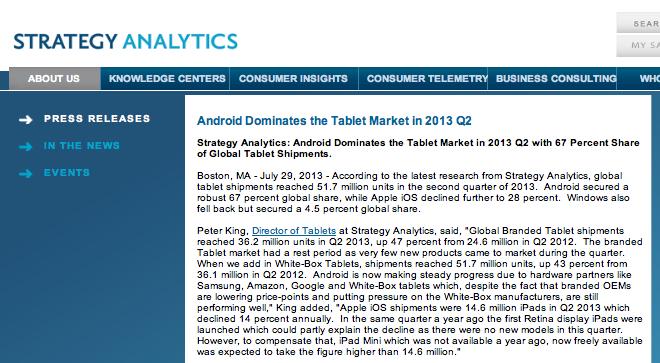
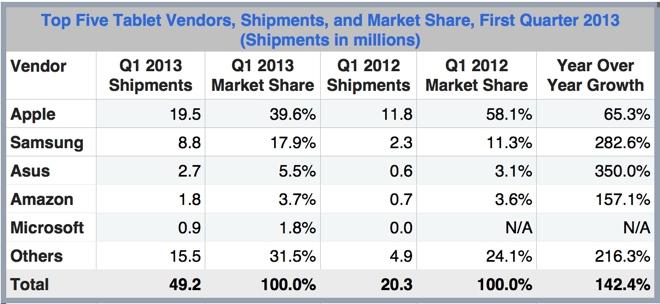
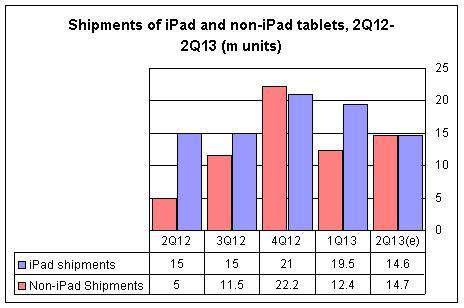

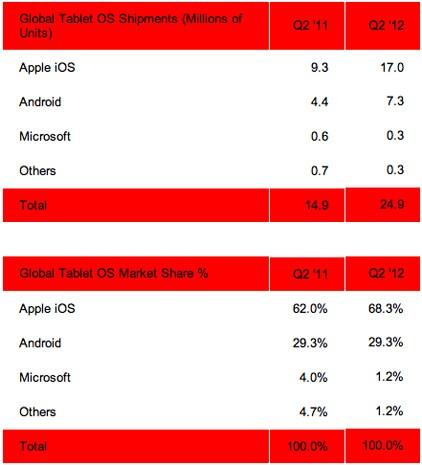

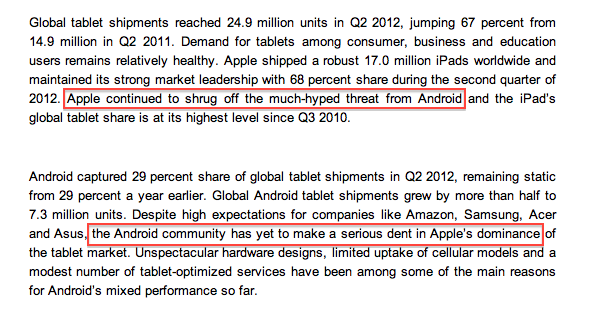
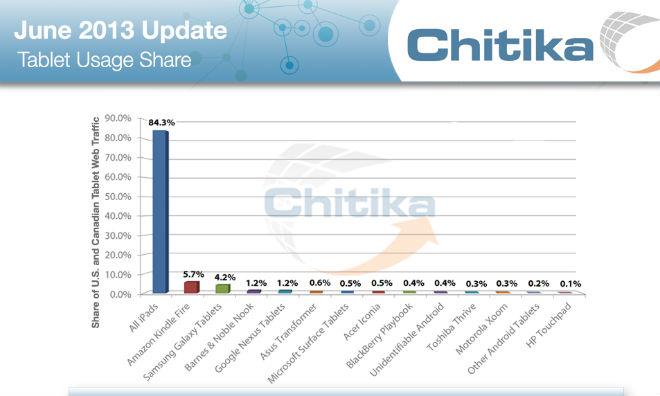







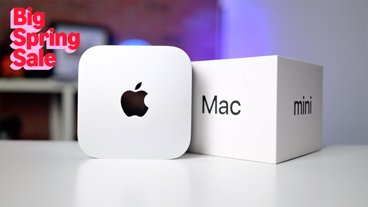
-m.jpg)






 Sponsored Content
Sponsored Content
 Malcolm Owen
Malcolm Owen
 William Gallagher
William Gallagher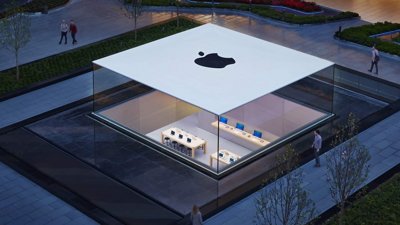
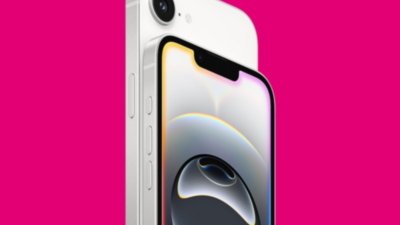
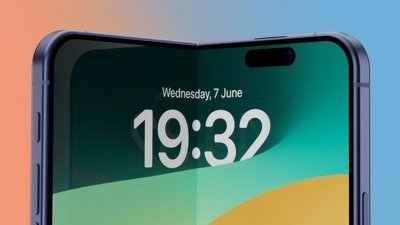
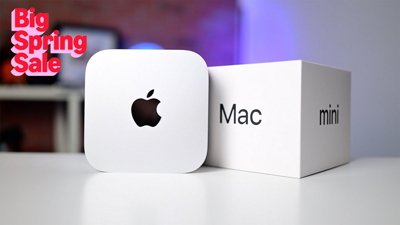
 Christine McKee
Christine McKee
 Wesley Hilliard
Wesley Hilliard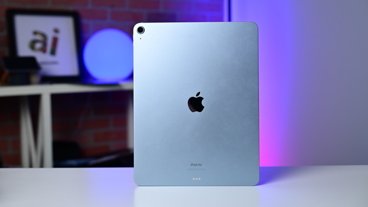





79 Comments
Wow, Android dominates the tablet market in Q2? Really? Well, Apple has a new products to announce and they have a lot of deals on the table. Isn't LA Unified School district going to be spending around $600 Mil outfitting all of their K-12 schools? There's around 700,000 kids that will be getting iPads over the next 6 months to a year. This a trend that is happening. With the various new models that Apple has waiting to come out, I'm sure Apple will recapture a lot of market share and profits from them.
That's funny. Outside of the Kindle/Nook, in the last year, I may have seen maybe one, maybe two "Android" type tablets being used in public - airports, airplanes, Starbucks/coffee shops, etc. Even for laptop usage in airports or Starbucks/Coffee shops, I generally see Macbooks outnumber the Win laptops 2-1 and sometimes as high as 90%
Market share does not matter if the ecosystem is not making money. Google has to keep telling the OEM's that the Android ecosystem is healthy and everybody else was making money. It kind of reminded me when the Republicans thought they were winning until the actual vote count.
So where are all these white box tablets? China?
I wonder if DED gets paid by the article or paid by the word. He certainly is thorough, if not long winded. That said, I enjoy the read and how he goes about poking huge holes in statistics.